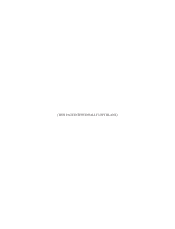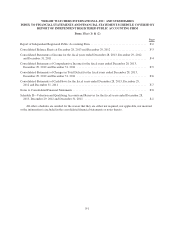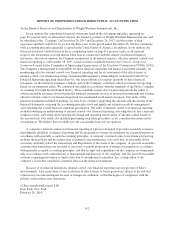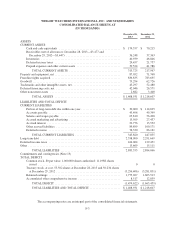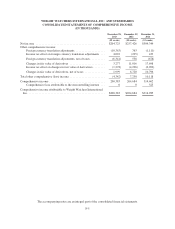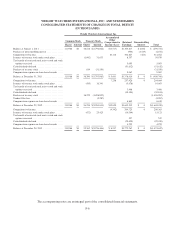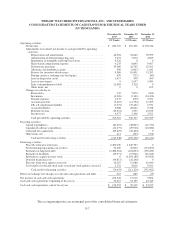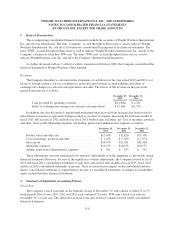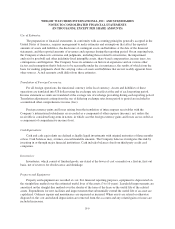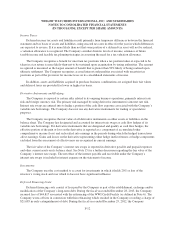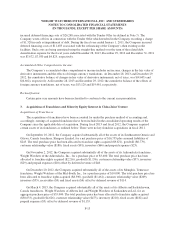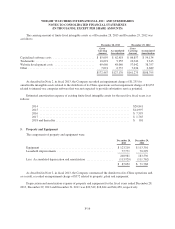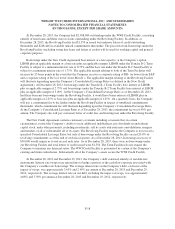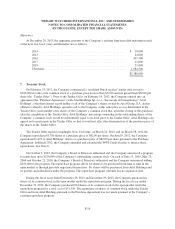WeightWatchers 2013 Annual Report Download - page 95
Download and view the complete annual report
Please find page 95 of the 2013 WeightWatchers annual report below. You can navigate through the pages in the report by either clicking on the pages listed below, or by using the keyword search tool below to find specific information within the annual report.WEIGHT WATCHERS INTERNATIONAL, INC. AND SUBSIDIARIES
NOTES TO CONSOLIDATED FINANCIAL STATEMENTS
(IN THOUSANDS, EXCEPT PER SHARE AMOUNTS)
Use of Estimates:
The preparation of financial statements, in conformity with accounting principles generally accepted in the
United States of America, requires management to make estimates and assumptions that affect the reported
amounts of assets and liabilities, the disclosure of contingent assets and liabilities at the date of the financial
statements, and the reported amounts of revenues and expenses during the reporting period. On an ongoing basis,
the Company evaluates its estimates and judgments, including those related to inventories, the impairment
analysis for goodwill and other indefinite-lived intangible assets, share-based compensation, income taxes, tax
contingencies and litigation. The Company bases its estimates on historical experience and on various other
factors and assumptions that it believes to be reasonable under the circumstances, the results of which form the
basis for making judgments about the carrying values of assets and liabilities that are not readily apparent from
other sources. Actual amounts could differ from these estimates.
Translation of Foreign Currencies:
For all foreign operations, the functional currency is the local currency. Assets and liabilities of these
operations are translated into US dollars using the exchange rate in effect at the end of each reporting period.
Income statement accounts are translated at the average rate of exchange prevailing during each reporting period.
Translation adjustments arising from the use of differing exchange rates from period to period are included in
accumulated other comprehensive income (loss).
Foreign currency gains and losses arising from the translation of intercompany receivables with the
Company’s international subsidiaries are recorded as a component of other expense (income), net, unless the
receivable is considered long-term in nature, in which case the foreign currency gains and losses are recorded as
a component of comprehensive income (loss).
Cash Equivalents:
Cash and cash equivalents are defined as highly liquid investments with original maturities of three months
or less. Cash balances may, at times, exceed insurable amounts. The Company believes it mitigates this risk by
investing in or through major financial institutions. Cash includes balances due from third-party credit card
companies.
Inventories:
Inventories, which consist of finished goods, are stated at the lower of cost or market on a first-in, first-out
basis, net of reserves for obsolescence and shrinkage.
Property and Equipment:
Property and equipment are recorded at cost. For financial reporting purposes, equipment is depreciated on
the straight-line method over the estimated useful lives of the assets (3 to 10 years). Leasehold improvements are
amortized on the straight-line method over the shorter of the term of the lease or the useful life of the related
assets. Expenditures for new facilities and improvements that substantially extend the useful life of an asset are
capitalized. Ordinary repairs and maintenance are expensed as incurred. When assets are retired or otherwise
disposed of, the cost and related depreciation are removed from the accounts and any related gains or losses are
included in income.
F-9



